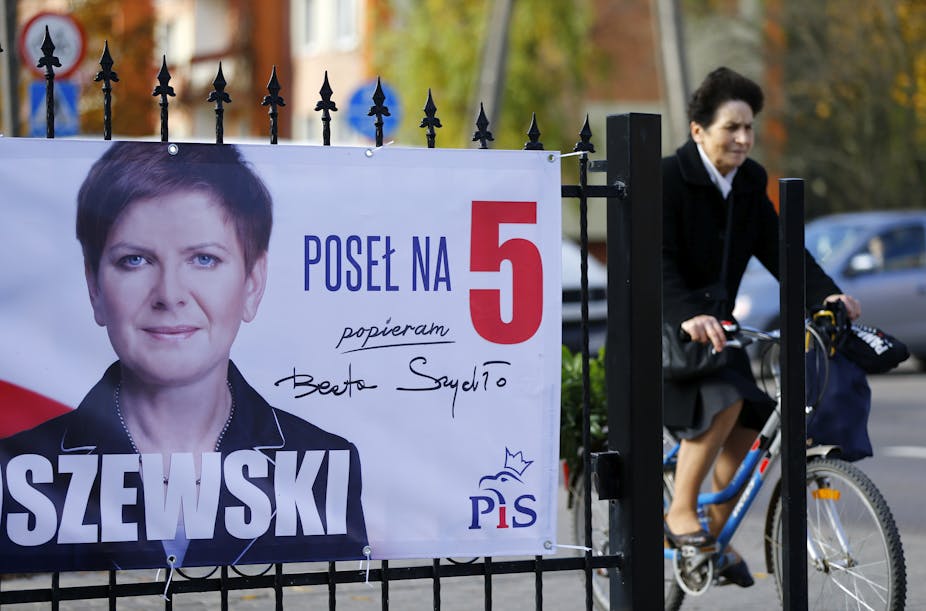With the results of Poland’s parliamentary election finally in, the Law and Justice (PiS), the nationalist conservative Eurosceptic party of the notorious Kaczyński twins, has won with 37.6% of the vote. It was trailed by the incumbent market-liberal and socially conservative Civic Platform (PO), which managed only a very weak 24.1%.
There was some good news for Poland’s three smaller parties. Two of them are new: the populist Kukiz’15, led by former presidential candidate and rock-star Paweł Kukiz, which won 39 seats in the 460-member lower house; and Modern (.N), a pro-market and socially liberal party founded just five months before the vote by economist Ryszard Petru, which won 31 seats.
Then, with 5.13% of the vote, there’s the agrarian Polish People’s Party (PSL), currently the junior party in the losing PO-led coalition and the only party to have sat in every single Polish parliament since 1991. The German Minority is expected to have secured two seats.
Although PiS’ victory is not in itself surprising – Jarosław Kaczyński’s party has been at the top of every poll for the last five months – the strength of its performance certainly is.
High and low
This is the first time since Poland’s first free and fair democratic parliamentary elections in 1991 that a single electoral bloc has managed to win an outright parliamentary majority. PiS also performed well across almost the entire country, flying in the face of the traditional divide between liberal western Poland and the more conservative east. It won in almost all voivodeships (states), including PO strongholds such as Mazowieckie, including Warsaw, driving the PO back into only Opolskie and Pomorskie.
PiS also has a strikingly broad voter base. Exit polls released by IPSOS on Sunday night show that it has been particularly successful among those who have only primary and lower secondary education and vocational training, those living in small villages, the unemployed and pensioners – but it still outperforms PO among almost all social and occupational groups.
Then there’s the youth vote. Deeply disaffected with the government, only 13.10% of students voted for PO, young people most turned to PiS (24.90%), Kukiz15 (20.90%) or the hard-right Eurosceptic Coalition for the Renewal of the Republic (KORWiN) (21.20%). Poland’s young people face high unemployment and many have not benefited from the country’s positive relatively stable economy; they are inclined to support any chance of change, whatever it might be, as long as it favours Poland and the Polish people first and foremost. That makes the PiS message highly appealing despite its conservatism.
Even more surprising is the defeat of the Democratic Left Alliance, the SLD – built from the remains of the old Communist left – which ran the country from 2001-5. Despite forming an alliance with four other parties of the left, it won an even smaller vote share than its disastrous 8.24% of the vote in 2011, and failed to pass the threshold required to get into parliament at all.
Combined with PiS’s surprisingly even support, this is surely the final nail in the coffin of the post-communist divide that characterised Polish politics between 1989 and 2005. As a result, the elections have all but gutted the left wing of the Polish parliament. With the exception of the PSL, a socially economic but Christian-democratic party that mostly represents farmers, all the other political forces in the forthcoming parliament are essentially on the right: both .N and PO are liberal, PiS is conservative, and Kukiz’15 populist radical-right.
Poland isn’t Ireland
Even as late as mid-April 2015, the PO had an almost 10-point lead over PiS. So how on earth did it manage to lose?

One of the reasons is that Poland’s relatively secure macro-economic situation has made no difference in the pockets of average Poles. Employment and job protection is precarious, salaries are low, prices have gone up and the quality of public services is well below par.
On top of that, the outgoing government passed unpopular pension reforms, raised the retirement age from 65 to 67, lowered the school starting age from seven to six and failed to tackle the social problems caused by the wave of emigration among young people – especially to the UK.
As the PiS wasted no time pointing out, the PO clearly failed to convert Poland into another Ireland, a leitmotif it relied on heavily in the 2011 campaign, while concerns on immigration and the refugee crisis are looming ever larger. Also, during its eight years in government, the PO has been hit by an array of scandals, including suspicions of corruption, (including by its PSL partners), state abuse (the so-called “tape affair”) and mismanagement of government resources. At the same time, the PO has lost a lot of appeal since its founder Donald Tusk, former Polish premier, left to become the president of the European Council.
Last but not least, ever since his surprise victory in the May 2015 presidential election, Poland’s president, Andrzej Duda, has been supporting the PiS’ campaign – if not directly, then at least indirectly, providing a stream of criticism and confrontational statements directed at the PO government.
So overnight, this result gutted the Polish left, humiliated an established government and for once seen a party win support the length and breadth of the country. Poland’s political landscape is, suddenly, almost unrecognisable.

